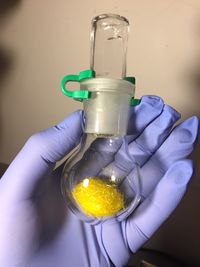Benzoquinone

| |
| Names | |
|---|---|
| IUPAC name
Cyclohexa-2,5-diene-1,4-dione
| |
| Other names
Benzoquinone
para-Benzoquinone Bara-quinone | |
| Properties | |
| C6H4O2 | |
| Molar mass | 108.10 g/mol |
| Appearance | Yellow solid |
| Odor | Acrid, chlorine-like |
| Density | 1.318 g/cm3 (at 20 °C) |
| Melting point | 115 °C (239 °F; 388 K) |
| Boiling point | Sublimes |
| 1.1 g/100 ml (18 °C) | |
| Solubility | Soluble in acetone Slightly soluble in benzene, diethyl ether, ethanol, petroleum ether |
| Vapor pressure | 0.1 mmHg at 25 °C |
| Hazards | |
| Safety data sheet | Sigma-Aldrich |
| Lethal dose or concentration (LD, LC): | |
| LD50 (Median dose)
|
130 mg/kg (rat, oral) 25 mg/kg (mouse, oral) |
| Related compounds | |
| Related compounds
|
Hydroquinone |
| Except where otherwise noted, data are given for materials in their standard state (at 25 °C [77 °F], 100 kPa). | |
| Infobox references | |
1,4-Benzoquinone, commonly known as para-quinone, is a chemical compound with the formula C6H4O2. In a pure state, it forms bright-yellow crystals with a characteristic irritating odor. This six-membered ring compound is the oxidized derivative of hydroquinone. The molecule is multifunctional: it exhibits properties of a ketone, forming an oxime; an oxidant, forming the dihydroxy derivative; and an alkene, undergoing addition reactions, especially those typical for α,β-unsaturated ketones. 1,4-Benzoquinone is sensitive toward both strong mineral acids and alkali, which cause condensation and decomposition of the compound.
It is an isomer of 1,2-benzoquinone.
Contents
Properties
Chemical
An acidic potassium iodide solution reduces a solution of benzoquinone to hydroquinone, which can be reoxidized back to the quinone with a solution of silver nitrate.
Physical
Benzoquinone forms bright yellow needle-like crystals. It is soluble in acetone and some organic solvents, but nearly insoluble in water and most polar solvents.
Benzoquinone readily undergoes sublimation, even at room temperature.
Availability
1,4-Benzoquinone is sold by chemical suppliers.
Preparation
Benzoquinone can be prepared by oxidation of hydroquinone.
Projects
- Make hydroquinone
- Make hydroxyquinol triacetate
Handling
Safety
Benzoquinone vapors are very irritating to the eyes and to the respiratory system. Handle in a well ventilated area, ideally in a fume cupboard.
Skin contact can result in brown staining, and apparently even localized tissue necrosis in severe cases. Benzoquinone is potentially a skin sensitizer.
Benzoquinone is probably carcinogenic.
Storage
Benzoquinone should be kept in tightly-closed glass bottles, such as flasks with a ground glass joint, or glass bottles with a PTFE seal cap. Plastic containers are unsuitable for storing this compound, as it stains/degrades polyethylene containers.
Disposal
Can be destroyed by oxidizing it with an oxidizing mixture, though due to its strong odor, this must be done outside or in a fumehood.